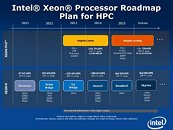Wednesday, July 3rd 2013

Intel 14-nanometer Skylake Platform To Support DDR4, PCIe 4.0, SATA Express
Intel's first chips based on the company's new, and Industry first, 14-nanometer manufacturing process are expected to hit markets in late 2015. With Skylake, Intel will introduce their new 9th-generation Intel HD IGP. The new platform will be the first to bring dual-channel DDR4 memory support. Skylake won't be the first platform to support DDR4 memory. In the 2H of 2014, Intel will launch their enthusiast grade Haswell-E platform, with support for quad-channel DDR4 memory. Skylake will be more of an evolution of Broadwell, which in turn is essentially an die shrink of Haswell to 14nm.
Additionally, the new mainstream platform will bring in support for PCI-E 4.0, essentially doubling the bandwidth offered by the current PCI-E 3.0 standard. More powerful GPUs from NVIDIA and AMD should be able to take advantage of the improved bandwidth, as their cards keep getting more and more powerful with each passing generation. Skylake will also introduce support for SATA Express. The advantage? SATA Express allows for a max bandwidth of about 16 Gb/s, more than 2.5x the 6 Gb/s bandwidth offered by the current SATA standard. While the product slide doesn't specify exactly as to when the first Skylake based products are scheduled to hit the market, our best guess places it at the end of 2015.
Source:
PC Games Hardware
Additionally, the new mainstream platform will bring in support for PCI-E 4.0, essentially doubling the bandwidth offered by the current PCI-E 3.0 standard. More powerful GPUs from NVIDIA and AMD should be able to take advantage of the improved bandwidth, as their cards keep getting more and more powerful with each passing generation. Skylake will also introduce support for SATA Express. The advantage? SATA Express allows for a max bandwidth of about 16 Gb/s, more than 2.5x the 6 Gb/s bandwidth offered by the current SATA standard. While the product slide doesn't specify exactly as to when the first Skylake based products are scheduled to hit the market, our best guess places it at the end of 2015.

36 Comments on Intel 14-nanometer Skylake Platform To Support DDR4, PCIe 4.0, SATA Express
Anyway Intel is increasing PCIe bandwidth on their mainstream platform instead of increasing PCIe lane count.
Also AVX 3.2 lol.
Despite that, having more lanes would be much more useful. Putting 48 lanes on the desktop and 96 lanes on the enthusiast/server platforms should be the standard, avoiding all those multiplexers and connecting 4-Way SLI systems with GPUs on different processors communicating through a QPI bus.
I wonder if my aging system will last till then. I really don't want to upgrade to Hasbeen/Haswell. I was hoping for 14nm to get here sooner.
There is absolutely no need for or advantage to having DDR4 and PCIe 4 on a current model desktop regardless of what CPU/APU it has. DDR4 is primarily for server use. It will be expensive, impractical for most desktop PCs and not offer any real advantage over LV DDR3 on the desktop.
PCIe 3.0 isn't even being widely used yet because PCIe 2.1 isn't a system limitation. More bandwidth on a system that isn't bandwidth limited makes no system performance gain.
All of this crap is marketing hype to try and boost sagging PC sales. It doesn't cost mobo makers more than a few pennies if that to use future standards that offer no real system performance gains. This allows the mobo makers to hype the future tech, charge even more excessive prices and the sheeple will spend their money like drunken sailors.
1) They said the same thing about DDR3 when DDR2 was the norm. I'm always an advocate for lower voltage memory if it's reasonable for consumers. Of course it starts off expensive, but what new hardware doesn't? Let them push it so that some time will go by without much demand, driving prices lower and lower.
2) PCI-E standards will always be way ahead of it's maximum usage. I noticed this since they came out with PCI-E 1.0. Case and point being that when GPU specs finally support a PCI-E standard, the PCI-E version has been widely available for like 6 months or something like that.
3) Embrace smaller, faster, more efficient tech. It's the only way things will evolve and not stay in a stale and rancid state. Then developers will find a need to create new programs/update existing programs in order to take advantage of the hardware that will eventually drive it.
4) SATA Express, now there's something I can't wait to see. Storage, the biggest bottleneck in desktop computing.
However, I do agree with you to some degree that a lot of this is marketing hype in order to get consumers to bite when new features are introduced is a bit like stealing candy from a baby. But at least we know enough not to fall into that trap....I think :laugh:
Fix it, please. Make it 2nd at least.
Honestly I got it out for new standerds, and yes while they seem not needed and incremental in changes they have greater potential in the evolution towards the "Tech of Tommorrow" :rockout:
Even the 990FX platform dating from 2011 has 38 lanes, where as the Z87 platform has only 24 :banghead:
The norm or standard is Q1, Q2 etc. Not 1H, 2H etc.